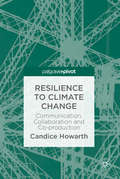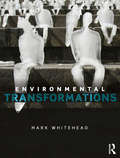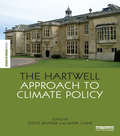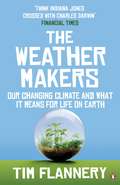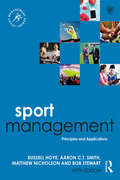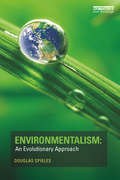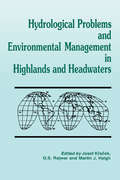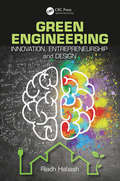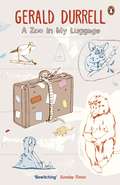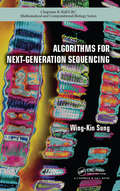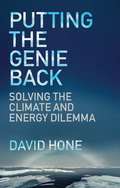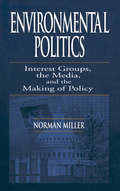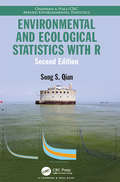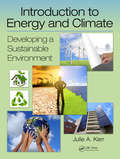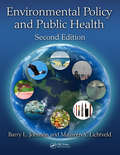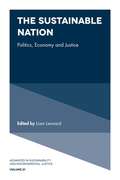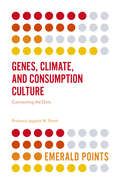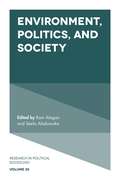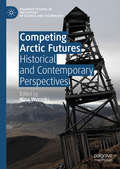- Table View
- List View
Resilience to Climate Change: Communication, Collaboration and Co-production
by Candice HowarthThe frequency and intensity of climate shocks such as heatwaves and flooding, are expected to increase under a changing climate with severe implications across the food, energy, water, environment nexus. This book critically explores how to improve resilience to climate shocks by examining the range of challenges and opportunities that exist in the aftermath of shocks and discusses factors that exacerbate and mitigate these. It innovatively discusses the importance of embedding communication, collaboration and co-production within resilience-building across sectors and stakeholders. Doing so with policy, practitioner and scientific communities, Candice Howarth argues, can pave the way to overcome challenges that emerge from climate shocks and facilitate the co-design of sustainable, robust and resilient responses.
Resilience to Climate Change: Communication, Collaboration and Co-production
by Candice HowarthThe frequency and intensity of climate shocks such as heatwaves and flooding, are expected to increase under a changing climate with severe implications across the food, energy, water, environment nexus. This book critically explores how to improve resilience to climate shocks by examining the range of challenges and opportunities that exist in the aftermath of shocks and discusses factors that exacerbate and mitigate these. It innovatively discusses the importance of embedding communication, collaboration and co-production within resilience-building across sectors and stakeholders. Doing so with policy, practitioner and scientific communities, Candice Howarth argues, can pave the way to overcome challenges that emerge from climate shocks and facilitate the co-design of sustainable, robust and resilient responses.
Environmental Transformations: A Geography of the Anthropocene
by Mark WhiteheadFrom the depths of the oceans to the highest reaches of the atmosphere, the human impact on the environment is significant and undeniable. These forms of global and local environmental change collectively appear to signal the arrival of a new geological epoch: the Anthropocene. This is a geological era defined not by natural environmental fluctuations or meteorite impacts, but by collective actions of humanity. Environmental Transformations offers a concise and accessible introduction to the human practices and systems that sustain the Anthropocene. It combines accounts of the carbon cycle, global heat balances, entropy, hydrology, forest ecology and pedology, with theories of demography, war, industrial capitalism, urban development, state theory and behavioural psychology. This book charts the particular role of geography and geographers in studying environmental change and its human drivers. It provides a review of critical theories that can help to uncover the socio-economic and political factors that influence environmental change. It also explores key issues in contemporary environmental studies, such as resource use, water scarcity, climate change, industrial pollution and deforestation. These issues are ‘mapped’ through a series of geographical case studies to illustrate the particular value of geographical notions of space, place and scale, in uncovering the complex nature of environmental change in different socio-economic, political and cultural contexts. Finally, the book considers the different ways in which nations, communities and individuals around the world are adapting to environmental change in the twenty-first century. Particular attention is given throughout to the uneven geographical opportunities that different communities have to adapt to environmental change and to the questions of social justice this situation raises. This book encourages students to engage in the scientific uncertainties that surround the study of environmental change, while also discussing both pessimistic and more optimistic views on the ability of humanity to address the environmental challenges of our current era.
Environmental Transformations: A Geography of the Anthropocene
by Mark WhiteheadFrom the depths of the oceans to the highest reaches of the atmosphere, the human impact on the environment is significant and undeniable. These forms of global and local environmental change collectively appear to signal the arrival of a new geological epoch: the Anthropocene. This is a geological era defined not by natural environmental fluctuations or meteorite impacts, but by collective actions of humanity. Environmental Transformations offers a concise and accessible introduction to the human practices and systems that sustain the Anthropocene. It combines accounts of the carbon cycle, global heat balances, entropy, hydrology, forest ecology and pedology, with theories of demography, war, industrial capitalism, urban development, state theory and behavioural psychology. This book charts the particular role of geography and geographers in studying environmental change and its human drivers. It provides a review of critical theories that can help to uncover the socio-economic and political factors that influence environmental change. It also explores key issues in contemporary environmental studies, such as resource use, water scarcity, climate change, industrial pollution and deforestation. These issues are ‘mapped’ through a series of geographical case studies to illustrate the particular value of geographical notions of space, place and scale, in uncovering the complex nature of environmental change in different socio-economic, political and cultural contexts. Finally, the book considers the different ways in which nations, communities and individuals around the world are adapting to environmental change in the twenty-first century. Particular attention is given throughout to the uneven geographical opportunities that different communities have to adapt to environmental change and to the questions of social justice this situation raises. This book encourages students to engage in the scientific uncertainties that surround the study of environmental change, while also discussing both pessimistic and more optimistic views on the ability of humanity to address the environmental challenges of our current era.
The Hartwell Approach to Climate Policy (The Earthscan Science in Society Series)
by Steve Rayner Mark CaineThe Hartwell Approach to Climate Policy presents a powerful critique of mainstream climate change policies and details a set of pragmatic alternatives based on the Hartwell Group’s collective writings from 1988-2010. Drawing on a rich history of heterodox but increasingly accepted views on climate change policy, this book brings together in a single volume a series of key, related texts that define the ‘Hartwell critique’ of conventional climate change policies and the ‘Hartwell approach’ to building more inclusive, pragmatic alternatives. This book tells of the story of how and why conventional climate policy has failed and, drawing from lessons learned, how it can be renovated. It does so by weaving together three strands of analysis. First, it highlights why the mainstream approach, as embodied by the Kyoto Protocol, has failed to produce real world reductions in greenhouse gas emissions and delayed real meaningful progress on climate change. Second, it explores the underlying political, economic, and technological factors which form the boundary conditions for climate change policy but which are often ignored by policy makers and advocates. Finally, it lays out a novel approach to climate change guided centrally by the goal of uplifting human dignity worldwide—and the recognition that this can only succeed if pursued pragmatically, economically, and with democratic legitimacy. With contributions from leading scholars in the field, this work presents a original critique of climate policy and a constructive primer for how to improve it.
The Hartwell Approach to Climate Policy (The Earthscan Science in Society Series)
by Steve Rayner Mark CaineThe Hartwell Approach to Climate Policy presents a powerful critique of mainstream climate change policies and details a set of pragmatic alternatives based on the Hartwell Group’s collective writings from 1988-2010. Drawing on a rich history of heterodox but increasingly accepted views on climate change policy, this book brings together in a single volume a series of key, related texts that define the ‘Hartwell critique’ of conventional climate change policies and the ‘Hartwell approach’ to building more inclusive, pragmatic alternatives. This book tells of the story of how and why conventional climate policy has failed and, drawing from lessons learned, how it can be renovated. It does so by weaving together three strands of analysis. First, it highlights why the mainstream approach, as embodied by the Kyoto Protocol, has failed to produce real world reductions in greenhouse gas emissions and delayed real meaningful progress on climate change. Second, it explores the underlying political, economic, and technological factors which form the boundary conditions for climate change policy but which are often ignored by policy makers and advocates. Finally, it lays out a novel approach to climate change guided centrally by the goal of uplifting human dignity worldwide—and the recognition that this can only succeed if pursued pragmatically, economically, and with democratic legitimacy. With contributions from leading scholars in the field, this work presents a original critique of climate policy and a constructive primer for how to improve it.
The Weather Makers: Our Changing Climate and what it means for Life on Earth
by Tim FlanneryThe Weather Makers tells the dramatic story of the earth's climate, of how it has changed, how we have come to understand it, and of what that means for the future. Tim Flannery's gripping narrative takes the reader on an extraordinary journey into the past and around the globe, bringing us closer to the science than ever before. Along the way he explodes the many illusions that have grown up around this subject.
Sport Management: Principles and Applications (Sport Management Series)
by Russell Hoye Aaron C.T. Smith Matthew Nicholson Bob StewartNow available in a fully revised and updated fifth edition, Sport Management: Principles and Applications tells you everything you need to know about the contemporary sport industry. Covering both the professional and nonprofit sectors, and with more international material than any other introductory sport management textbook, it focuses on core management principles and their application in a sporting context, highlighting the unique challenges of a career in sport management. The book contains useful features throughout, including conceptual overviews, guides to further reading, links to important websites, study questions, and up-to-date case studies showing how theory works in the real world. It covers every core functional area of management, including: Strategic planning Financial management Organizational culture and design Human resource management Leadership and governance Marketing and sponsorship Performance management Sport and the media. The fifth edition includes expanded coverage of sport for development, analytics, monitoring and evaluation, ethics, risk management, sport and health, social media, sustainability, and other contemporary management issues. Complemented by a companion website offering additional resources for students and instructors, this is an ideal textbook for first and second year students in sport management degree programs and for business students seeking an overview of applied sport management principles.
Environmentalism: An Evolutionary Approach
by Douglas SpielesThe premise of this book is that our environmental dilemmas are products of biological and sociocultural evolution, and that through an understanding of evolution we can reframe debates of thought and action. The purpose is to explain the wide variety of environmental worldviews, their origins, commonalities, points of contention, and their implications for the modern environmental movement. In three parts covering the origins, evolution and future of environmentalism, it offers instructors and students a framework on which to map theory, case studies and classical literature. It is shown that environmentalism can be described in terms of six human values—utility, stability, equity, beauty, sanctity, and morality—and that these are deeply rooted in our biological and cultural origins. In building this case the book draws upon ecology, philosophy, psychology, history, biology, economics, spirituality, and aesthetics, but rather than consider these all independently it integrates them to craft a mosaic narrative of our species and its home. From our evolutionary origins a story emerges; it is the story of humankind, how we have come to threaten our own existence, and why we seem to have such difficulty in acting together to ensure our common future. Understanding our environmental problems in evolutionary terms gives us a way forward. It suggests an environmentalism in which material views of human life include spirituality, in which our anthropocentric behaviors incorporate ecological function, and in which environmental problems are addressed by the intentional relation of humans to the nonhuman world and to one another. Aimed at students taking courses in environmental studies, the book brings clarity to a complex and, at times, confusing array of ideas and concepts of environmentalism.
Hydrological Problems and Environmental Management in Highlands and Headwaters
by Martin HaighThis set of papers presents a description of the synthesis of hydrological problems and various environmental implications and management strategies for different highland and headwater regions of the world. Regions covered include the Himalayas, Russian mountains, Amazonia, and upland Wales.
Green Engineering: Innovation, Entrepreneurship and Design
by Riadh HabashThis is a primary text project that combines sustainability development with engineering entrepreneurship and design to present a transdisciplinary approach to modern engineering education. The book is distinguished by extensive descriptions of concepts in sustainability, its principles, and its relevance to environment, economy, and society. It can be read by all engineers regardless of their disciplines as well as by engineering students as they would be future designers of products and systems. This book presents a flexible organization of knowledge in various fields, which allows to be used as a text in a number of courses including for example, engineering entrepreneurship and design, engineering innovation and leadership, and sustainability in engineering design
A Zoo in My Luggage: A Zoo In My Luggage, The Whispering Land, And Menagerie Manor (The\zoo Memoirs Ser. #1)
by Gerald DurrellThe true and hilarious story of how Gerald Durrell and his wife set up their own zoo. Journeying to the Cameroons, he and his wife, helped by the renowned Fon of Bafut, managed to collect 'plenty beef.' Their difficulties began when they found themselves back at home, with Cholmondely the chimpanzee, Bug-Eye the bush-baby, and other founder members... and nowhere to put them
Algorithms for Next-Generation Sequencing (Chapman & Hall/CRC Computational Biology Series)
by Wing-Kin SungAdvances in sequencing technology have allowed scientists to study the human genome in greater depth and on a larger scale than ever before – as many as hundreds of millions of short reads in the course of a few days. But what are the best ways to deal with this flood of data? Algorithms for Next-Generation Sequencing is an invaluable tool for students and researchers in bioinformatics and computational biology, biologists seeking to process and manage the data generated by next-generation sequencing, and as a textbook or a self-study resource. In addition to offering an in-depth description of the algorithms for processing sequencing data, it also presents useful case studies describing the applications of this technology.
Putting the Genie Back: Solving the Climate and Energy Dilemma
by David HoneOn November 4th 2016 the Paris Agreement entered into force. The warming of the climate system, first recognized over a century ago, has become one of the key political and social issues of our time. Some still deny it is happening, others are incensed by the slow pace of change, while most are left confused and uncertain not just by the science, but by the panoply of solutions put forward by politicians, business people, academics and activists. At its most ambitious, the Paris Agreement implies a transition within the global energy system such that carbon dioxide emissions fall rapidly from 40 billion tonnes per annum in 2016, to net-zero by the middle of the century. Yet our fossil fuel based energy system which ushered in the Industrial Revolution nearly 200 years ago continues to grow and evolve even as new sources of energy come into the market and compete. The principal economic instrument for change is clear and has been for over two decades, but in 2017 only a fraction of the global economy actively employs government led carbon pricing policies and within that only a handful of systems operate at a level commensurate with the pace and scale of change that is necessary. As deployment of new energy technologies accelerates, can solutions be found to cover the full range of services delivered by fossil fuels and can warming be limited to the agreed global goals? Putting the Genie Back explores the climate issue from its very beginnings through to the end of end of the 21st Century and looks in depth at the transition challenge we collectively face.
Environmental Politics: Interest Groups, the Media, and the Making of Policy
by Norman MillerAt every stage, environmental policy is the result of the combat of stakeholders interested in, and affected by, the problem being addressed and the range of possible solutions. The combatants include any or all of the following: the federal government, environmental advocacy groups, and business, the media, the scientific community, think tanks, NGOs of every stripe, trade associations and professional organizations, and even state and local governments, each of whom have their own interests in the resulting policy. Environmental Politics: Interest Groups, the Media, and the Making of Policy discusses political battles over the environment from ground level - as they are fought in legislative chambers, the daily newspaper, on television, and, increasingly, on the Internet. The text explores environmental politics as a clash of interests, not ideologies, and environmental policy as a result of the reconciliation of those interests. The author covers not only the conventional aspects of the policymaking process but more recent and less recognized elements and developments such as:Proliferation of legislative riders and monument designations as major environmental strategiesEvolving role of the media, from science popularizer to agenda setterGrowing influence on both Congress and the public of conservative and libertarian foundations and think tanksDevolution of environmental power from the Federal to state governmentsMetamorphosis of EPA in a business-driven regulatory revolutionEffect of globalization on US environmental policyNewly emerging role of the precautionary principle in marrying science and politicsIncreasing role of the Internet in promoting populist issues and promoting the decentralization of the environmental power structureNo other book covers the politics of the environment the way this one does. Written by an expert with 25 years of experience in environmental policymaking, Environmental Politics: Interest Groups, the Media, and the Making of Policy gives you an insider's view of how policies are forged. By examining these issues through an interest group lens, this book not only accounts for what policies have been adopted but also shows how you can influence policy and effect change.
Environmental and Ecological Statistics with R (Chapman & Hall/CRC Applied Environmental Statistics)
by Song S. QianEmphasizing the inductive nature of statistical thinking, Environmental and Ecological Statistics with R, Second Edition, connects applied statistics to the environmental and ecological fields. Using examples from published works in the ecological and environmental literature, the book explains the approach to solving a statistical problem, covering model specification, parameter estimation, and model evaluation. It includes many examples to illustrate the statistical methods and presents R code for their implementation. The emphasis is on model interpretation and assessment, and using several core examples throughout the book, the author illustrates the iterative nature of statistical inference. The book starts with a description of commonly used statistical assumptions and exploratory data analysis tools for the verification of these assumptions. It then focuses on the process of building suitable statistical models, including linear and nonlinear models, classification and regression trees, generalized linear models, and multilevel models. It also discusses the use of simulation for model checking, and provides tools for a critical assessment of the developed models. The second edition also includes a complete critique of a threshold model. Environmental and Ecological Statistics with R, Second Edition focuses on statistical modeling and data analysis for environmental and ecological problems. By guiding readers through the process of scientific problem solving and statistical model development, it eases the transition from scientific hypothesis to statistical model.
Introduction to Energy and Climate: Developing a Sustainable Environment
by Julie KerrThe purpose of this textbook is to provide a well-rounded working knowledge of both climate change and environmental sustainability for a wide range of students. Students will learn core concepts and methods to analyze energy and environmental impacts; will understand what is changing the earth’s climate, and what that means for life on earth now and in the future. They will also have a firm understanding of what energy is and how it can be used. This text intends to develop working knowledge of these topics, with both technical and social implications. Students will find in one volume the integration and careful treatment of climate, energy, and sustainability.
Putting the Genie Back: Solving the Climate and Energy Dilemma
by David HoneOn November 4th 2016 the Paris Agreement entered into force. The warming of the climate system, first recognized over a century ago, has become one of the key political and social issues of our time. Some still deny it is happening, others are incensed by the slow pace of change, while most are left confused and uncertain not just by the science, but by the panoply of solutions put forward by politicians, business people, academics and activists. At its most ambitious, the Paris Agreement implies a transition within the global energy system such that carbon dioxide emissions fall rapidly from 40 billion tonnes per annum in 2016, to net-zero by the middle of the century. Yet our fossil fuel based energy system which ushered in the Industrial Revolution nearly 200 years ago continues to grow and evolve even as new sources of energy come into the market and compete. The principal economic instrument for change is clear and has been for over two decades, but in 2017 only a fraction of the global economy actively employs government led carbon pricing policies and within that only a handful of systems operate at a level commensurate with the pace and scale of change that is necessary. As deployment of new energy technologies accelerates, can solutions be found to cover the full range of services delivered by fossil fuels and can warming be limited to the agreed global goals? Putting the Genie Back explores the climate issue from its very beginnings through to the end of end of the 21st Century and looks in depth at the transition challenge we collectively face.
Environmental Policy and Public Health
by Barry L. Johnson Maureen Y. LichtveldAs with the first edition, this second edition describes how environmental health policies are developed, the statutes and other policies that have evolved to address public health concerns associated with specific environmental hazards, and the public health foundations of the policies. It lays out policies for what is considered the major environmental physical hazards to human health. Specifically, the authors describe hazards from air, water, food, hazardous substances, and wastes. To this list the authors have added the additional concerns from climate change, tobacco products, genetically-modified organisms, environment-related diseases, energy production, biodiversity and species endangerment, and the built environment. And as with the first edition, histories of policymaking for specific environmental hazards are portrayed. This edition differs from its antecedent in three significant themes. Global perspectives are added to chapters that describe specific environmental hazards, e.g., air pollution policies in China and India. Also there is the material on the consequences of environmental hazards on both human and ecosystem health. Additionally readers are provided with information about interventions that policymakers and individuals can consider in mitigating or preventing specific environmental hazards.
The Sustainable Nation: Politics, Economy and Justice (Advances in Sustainability and Environmental Justice #21)
by Liam LeonardDrawing on almost 20 years of Liam Leonard’s research in the field, The Sustainable Nation: Politics, Economy and Justice provides a detailed case study of a modern European state’s tumultuous development through first decades of the Millennium. As the Republic of Ireland experienced an initial phase of accelerated growth, followed by a dramatic economic downturn, the nation’s attempts to expand its infrastructure was met with resistance from communities concerned about local environments. The Sustainable Nation: Politics, Economy and Justice looks at some of the conflicts that emerged as part of the Irish people’s attempts to achieve a sustainable form of development. Other issues such as the rise of a multicultural and globalized society as well as issues of social justice are also explored within this study. This book represents a culmination of Leonard's research on Ireland which began at the turn of the Millennium. The book provides an in depth and up to date study on Ireland's growth and the substantial changes experienced there during the last two decades.
The Sustainable Nation: Politics, Economy and Justice (Advances in Sustainability and Environmental Justice #21)
by Liam LeonardDrawing on almost 20 years of Liam Leonard’s research in the field, The Sustainable Nation: Politics, Economy and Justice provides a detailed case study of a modern European state’s tumultuous development through first decades of the Millennium. As the Republic of Ireland experienced an initial phase of accelerated growth, followed by a dramatic economic downturn, the nation’s attempts to expand its infrastructure was met with resistance from communities concerned about local environments. The Sustainable Nation: Politics, Economy and Justice looks at some of the conflicts that emerged as part of the Irish people’s attempts to achieve a sustainable form of development. Other issues such as the rise of a multicultural and globalized society as well as issues of social justice are also explored within this study. This book represents a culmination of Leonard's research on Ireland which began at the turn of the Millennium. The book provides an in depth and up to date study on Ireland's growth and the substantial changes experienced there during the last two decades.
Genes, Climate, and Consumption Culture: Connecting the Dots (Emerald Points)
by Professor Jagdish N. ShethDrawing from decades of research, Genes, Climate, and Consumption Culture: Connecting the Dots demonstrates how climate dictates culture and consumption. The author shows that human genes are climatic adaptations over thousands of years of evolution, which has resulted in the dramatic differences between people’s food, clothing, and shelter choices. Most importantly, the book discusses how many of the fundamental differences between cultures, with respect to time, space, friendship, and technology, are responses to their particular climate. Readers will learn how to challenge their assumptions about what types of products and services foreign markets want. They will learn how to examine local markets vis-à-vis climate and culture, either changing their products accordingly or delivering entirely new offerings.
Environment, Politics and Society (Research in Political Sociology #25)
by Ramakrishnan Alagan Seela AladuwakaThis special volume of Research in Political Sociology addresses the interconnectivity of environment, politics and society. Contributors engage with critical topics such as water resource management, climate change, civil rights, poverty and social inequality, green transportation and brain drain, and examines these issues internationally in North America, South America, Asia and the Middle East. In the midst of vigorous discussions on environmental sustainability and crises that make global communities more vulnerable than ever before, on local, regional, and global scales, the chapters in this volume offer a much-needed dialogue, and will be of interest to politicians, policymakers and scientists as well as academic researchers.
Competing Arctic Futures: Historical and Contemporary Perspectives (Palgrave Studies in the History of Science and Technology)
by Nina WormbsThis edited collection explores how narratives about the future of the Arctic have been produced historically up until the present day. The contemporary deterministic and monolithic narrative is shown to be only one of several possible ways forward. This book problematizes the dominant prediction that there will be increased shipping and resource extraction as the ice melts and shows how this seemingly inevitable future has consequences for the action that can be taken in the present. This collection looks to historical projections about the future of the Arctic, evaluating why some voices have been heard and championed, while others remain marginalised. It questions how these historical perspectives have shaped resource allocation and governance structures to understand the forces behind change in the Arctic region. Considering the history of individuals and institutions, their political and economic networks and their perceived power, the essays in this collection offer new perspectives on how the future of the Arctic has been produced and communicated.
Competing Arctic Futures: Historical and Contemporary Perspectives (Palgrave Studies in the History of Science and Technology)
by Nina WormbsThis edited collection explores how narratives about the future of the Arctic have been produced historically up until the present day. The contemporary deterministic and monolithic narrative is shown to be only one of several possible ways forward. This book problematizes the dominant prediction that there will be increased shipping and resource extraction as the ice melts and shows how this seemingly inevitable future has consequences for the action that can be taken in the present. This collection looks to historical projections about the future of the Arctic, evaluating why some voices have been heard and championed, while others remain marginalised. It questions how these historical perspectives have shaped resource allocation and governance structures to understand the forces behind change in the Arctic region. Considering the history of individuals and institutions, their political and economic networks and their perceived power, the essays in this collection offer new perspectives on how the future of the Arctic has been produced and communicated.
